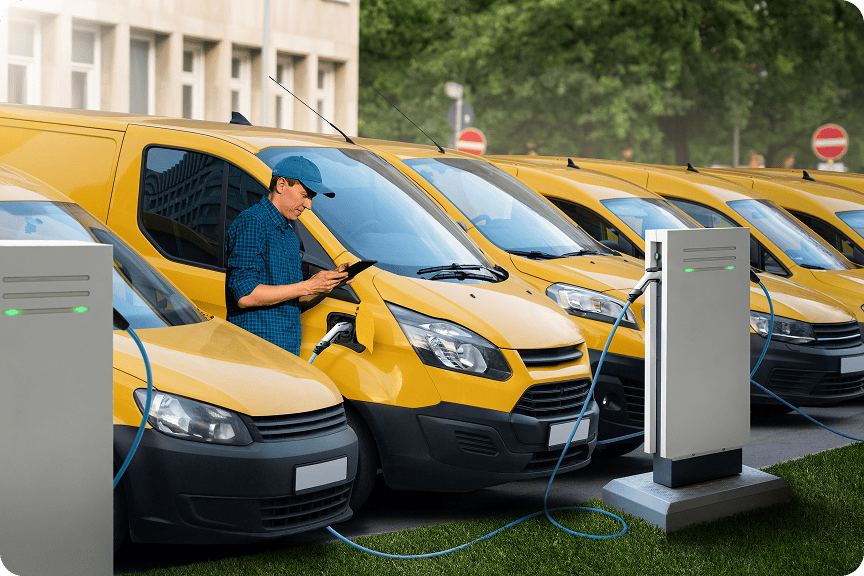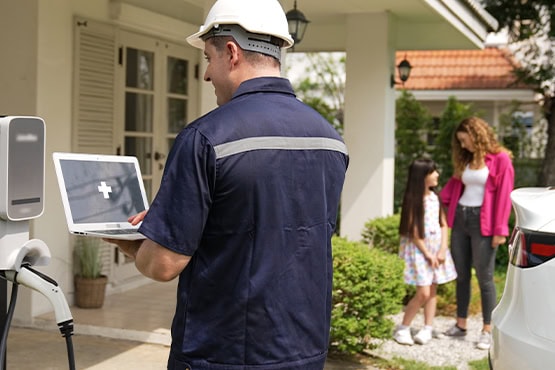
Managed charging is a foundational tool for making that system more flexible, efficient, and equitable. By coordinating when and how EVs charge, we can support grid stability, reduce energy costs, and accelerate renewable energy adoption.
Managed charging—also known as smart charge management—refers to strategies that shift EV charging away from periods of local or system-wide grid peak demand use (when energy is the most expensive) and toward periods when electricity is cleaner and more affordable. These shifts aren’t arbitrary: they’re driven by real-time system conditions, customer preferences, and grid priorities.
In practice, managed charging is the coordination of four things:
A signal from the utility, grid operator, or software platform
A mechanism to influence behavior (like pricing or direct control)
A technology that executes the strategy, whether on the vehicle or the charger
A transaction and settlement method to recognize participation and evaluate results
Together, these tools enable EVs to function not just as loads, but as flexible grid resources.
As EV adoption grows, unmanaged charging risks pushing the electric grid beyond its limits, especially during peak hours. That could mean higher rates for customers, delayed interconnections, and costly infrastructure upgrades.
But when charging is managed effectively, it becomes a strategic asset. Managed charging can:
The key isn’t just shifting energy use, it’s doing it in ways that work for drivers, operators, and the electric system at the same time.
93% of EV charging was shifted out of peak hours during Marin Clean Energy’s managed charging pilot, reducing emissions by 55% and saving customers money.
(Source: SEPA State of Managed Charging 2024 Report)
Managed charging programs vary in complexity and strategy. Most include a combination of design models, technology approaches, and platform partners.
110 managed charging programs were surveyed nationwide. Most lacked certified interoperability or scalable program design.
(Source: LBNL/NREL Smart Charge Management Gap Analysis, 2024)
As managed charging programs expand, one thing is clear: scale is not just about size, it’s about coordination, simplicity, and trust. Early pilots have shown that managed charging can reduce costs, improve reliability, and support clean energy. But unlocking these benefits widely means addressing key program design challenges.
Programs that simplify enrollment, offer meaningful incentives, and clearly communicate value see higher engagement.
Fragmented communication standards across EVSEs, vehicles, and platforms make it harder to scale participation and verify results.
Limited insight into grid constraints and real-time load impacts hinder planning and quantification of avoided upgrades.
Many systems lack end-to-end verification of their managed charging capabilities, slowing utility and regulator confidence.
These challenges aren’t roadblocks—they’re the areas where better coordination, shared standards, and thoughtful program design can unlock faster progress. That’s the work ahead, and EVCAN is here to help.

At EVCAN, we see managed charging as an important lever to accelerate deployment of safe, reliable, and accessible EV charging. Here are the ways we aim to support market scale of managed charging:
Established capabilities and technical criteria for charge management systems that encourage interoperability, reliability, and safety for charging networks.
A searchable directory of Charge Station Management Systems (CSMS) verified for interoperability, energy management, charging reliability and data transparency.
Webinars and presentations with organizational partners to share information about the Technical Specification and how to get a charge management system qualified.